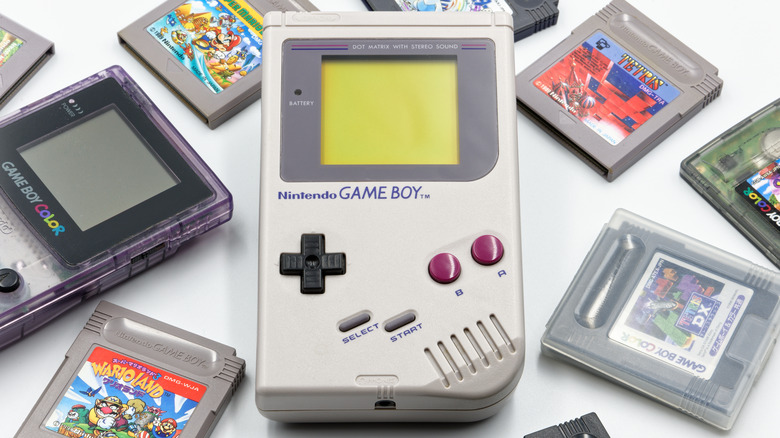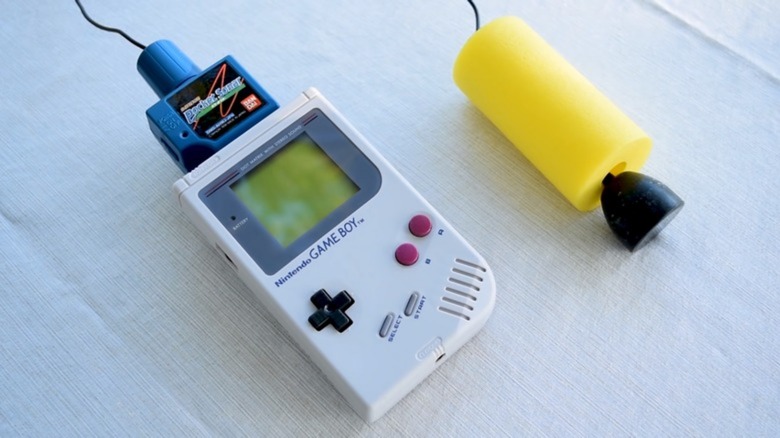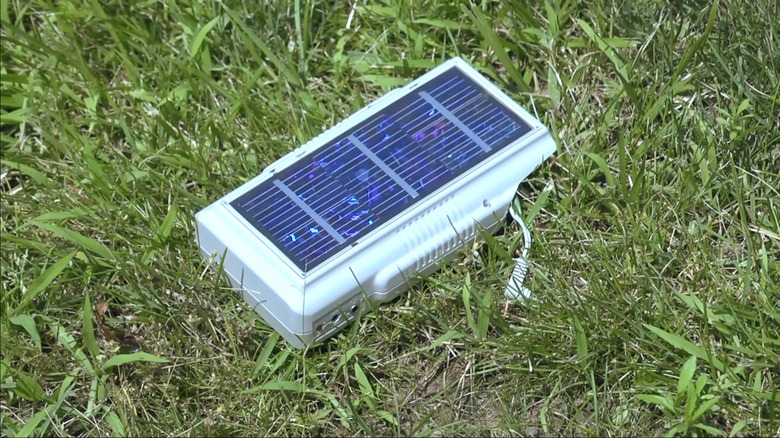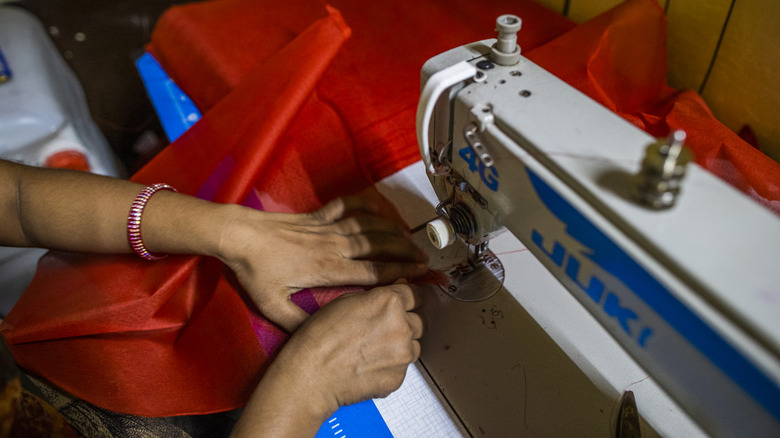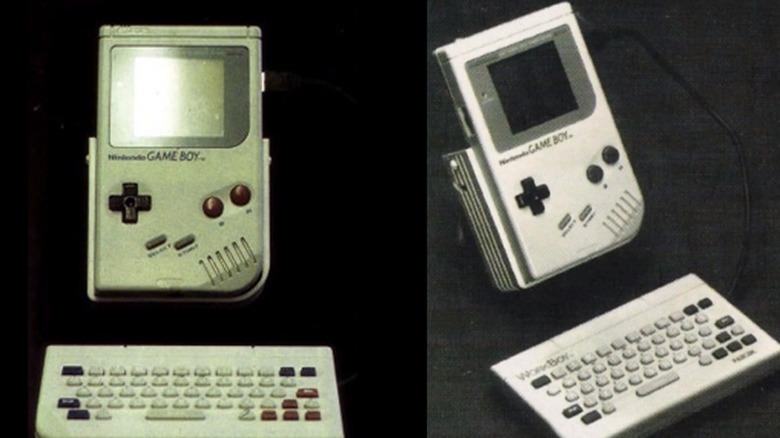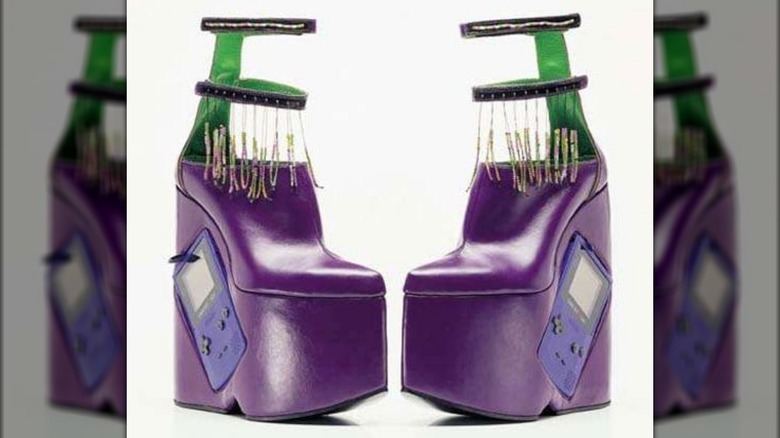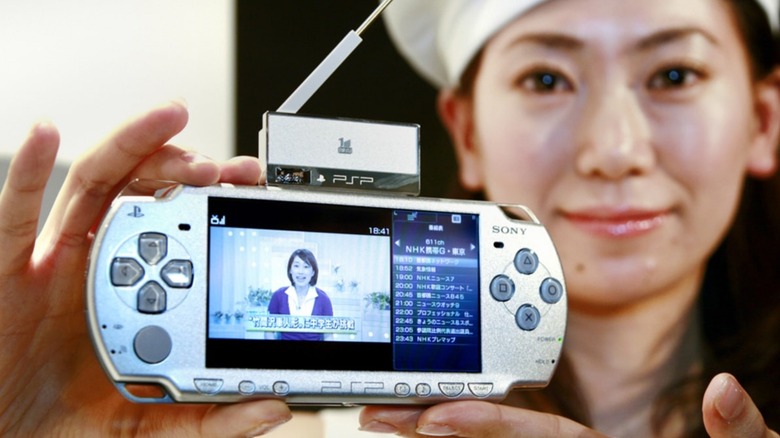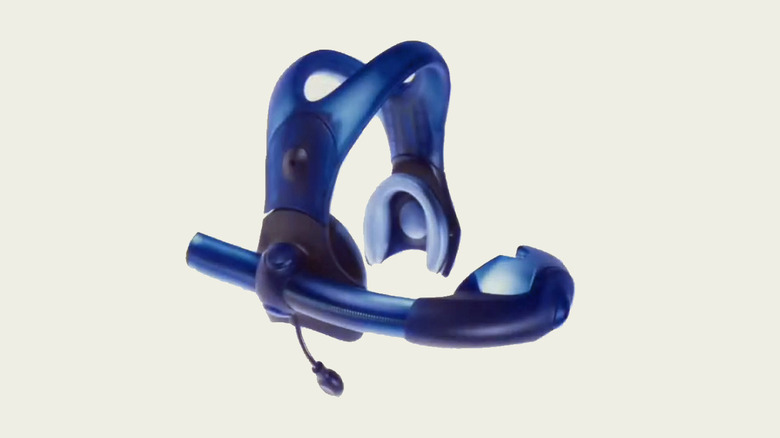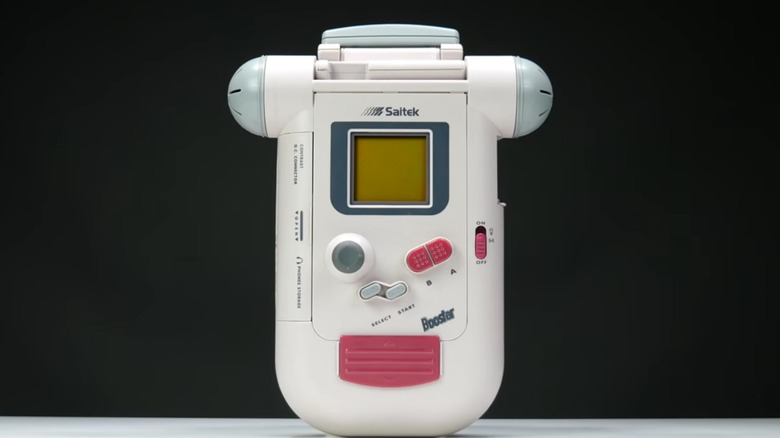8 Of The Weirdest Handheld Gaming Accessories Ever Made
If video games revolutionized the entertainment industry, handheld game consoles revolutionized the video game industry. Most game consoles are only usable if you plug them into a wall outlet and TV, but anyone can take and play handhelds anywhere. Given how many people are constantly on the go, it's no wonder why handheld consoles, especially Nintendo's, became so popular. And with that popularity came accessories.
To be fair, third-party manufacturers have been producing optional accessories meant to accentuate the gaming experience ever since video games were invented — "meant" being the operative word. If you walk into an electronics store or shop online, it's difficult not to find at least one essential Switch accessory, two pointless Xbox add-ons, and countless weird PC peripherals. However, since handhelds are so unlike other game consoles, what would you develop for these pocket-sized consoles if you were a third-party manufacturer? The answer is a ton of eccentric devices that would never work for household consoles, and here are some of the weirdest of the already weird bunch.
Game Boy Pocket Sonar
Fishing is a fun and calming experience. While merely casting out a fishing line and soaking in the ambience of nature is zen-like, few things are quite as thrilling as hooking a fish and reeling it in, which is easier said than done when you can't see them below the surface.
The Game Boy Pocket Sonar is a fishing accessory that could fit inside your pocket, hence its name — it was also designed for the Game Boy Pocket, so the name is a cute double entendre. Unlike most Game Boy cartridges, the Game Boy Pocket Sonar featured a prominent yellow foam bobber that housed the sonar. All one had to do was toss the sonar part into a body of water (and feed the cartridge 4 AA batteries), and it would display its findings on the Game Boy's screen. The sonar also came with a waterproof pouch users could hang around their neck since the Game Boy should never take a dip in water.
On one hand, the Game Boy Pocket Sonar looks weird since it's a fluffy sonar device attached to a Game Boy to find fish. The mere act of wearing it is going to turn heads. But on the other hand, it worked. Unlike countless other video game accessories of the time, the Game Boy Pocket Sonar functioned as advertised and actually located fish, which is a miracle in and of itself. Plus, the sonar's cartridge included a game that was basically a fish encyclopedia, which is a cool bonus.
Game Boy Solar Charger
The Game Boy was released long before Nintendo (or any other console manufacturer for that matter) started using rechargeable batteries. The original model went through AAs with shocking regularity, leaving many gamers in need of alternate charging solutions, one of which involved a readily available source of renewable energy: the sun.
As its name suggests, the Game Boy Solar Charger was a solar panel that was larger than an OG Game Boy. To use it, you had to leave the device out in the sun for up to eight hours, slot the Game Boy into the charger's open side, and plug the accessory into the DC input port. Assuming the internal battery wasn't busted, a full charge granted six hours of playtime. For comparison, that's longer than the average Nintendo Switch's max gameplay session.
While the Game Boy Solar Charger is yet another accessory that worked as intended, to use it, you had to keep it attached to the handheld, which almost doubled its already sizable form factor. And because of where the DC cable was located, the charger wasn't compatible with anything other than the initial Game Boy models. Still, we could use more solar charger battery solutions in the world of modern gaming. Perhaps a solar charger for the Nintendo Switch or Steam Deck?
Sewing Machine
Sewing is far from an easy task. It takes a lot of practice, and while sewing machines make the process easier, even those devices require a level of expertise (and monetary investment), especially if you want to use novelty stitches or embroider. However, a computer-aided, or Game Boy-aided, sewing machine can help.
In the early 2000s, the Japanese company Jaguar Sewing Machines partnered with Nintendo to create a Game Boy-powered sewing machine. This device, the Jaguar JN-1000, plugged into a Game Boy and used a proprietary cartridge to create a variety of stitches and embroideries, including custom patterns. As strange as this collaboration might sound, it proved successful — especially with young audiences — despite its prohibitively high price tag.
Jaguar sold several versions of the JN-1000, including a deluxe bundle that shipped with a Game Boy Pocket. Moreover, the American company Singer was allowed to license the sewing machine and sell it as the Izek, Game Boy and all. Jaguar later sold a follow-up, the JN-2000, aka the Nuotto, which could produce more detailed embroidery patterns. This version supported new cartridges for custom embroidery projects featuring "Super Mario" characters, and it also included a cradle to hold a Game Boy Color during sewing. Jaguar and Nintendo also wanted to sell a cartridge that would let users embroider Pokemon onto their clothes, but for unknown reasons, they never did.
WorkBoy
Laptops have been around since 1981, but they were large, clunky machines that required AC outlets. Plus, many were far too expensive for the average person. How could an office worker get some data management done if they were stuck on a train? Well, they could always use a Game Boy for something other than gaming.
The WorkBoy was a stand, keyboard, and cartridge that could transform the Game Boy into a makeshift workstation. The device was supposed to include a variety of managerial applications, including record keeping, phone number storage, and appointment management. Since Game Boys were cheap at the time compared to laptops, the WorkBoy sounded like the perfect way to perform basic office tasks on the go, but it never surfaced.
Nintendo and Fabtek Inc. showed off the WorkBoy at several consumer electronics shows, and the gadget impressed journalists enough to receive several stories and ads in magazines. Plus, the companies announced they would release the WorkBoy at a 1992 GamesMaster event. That never happened. Nintendo and Fabtek quietly canceled the product, and nobody is sure why. The general public never saw the WorkBoy again, at least until 2020 when DidYouKnowGaming's Liam Robertson obtained a rare WorkBoy keyboard prototype from Fabtek's founder, Frank Ballouz. Turns out he had one of the last functional WorkBoy keyboards in existence, which also was one of the first Fabtek ever produced. And if hackers hadn't leaked unreleased Nintendo ROMs to the Internet, Robertson would never have gotten the keyboard to work.
Platform Shoes
While consoles like the Nintendo Game Boy and Sega Game Gear were small enough to be portable, users still needed to store them while on the go. Many companies capitalized on this need with carrying cases, but for some reason, Nintendo thought it was a good idea to literally step on Game Boys.
In the early 2000s, designer Helen Red Richards worked with Nintendo to create arguably the most unusual platform shoes to ever grace a fashion show. These shoes were designed around the Game Boy Color, and not in the "they utilized Game Boy Color shapes and iconography for themes" sense. In a bizarre blending of form meeting function, these shoes actually stored Game Boy Colors, albeit in questionable ways. Some had storage slots for the consoles in their raised platforms, while others secured the handhelds with straps on the tongues or heels.
Not only were these platform shoes displayed in art galleries, but they also were for sale. Sort of. Each pair was custom made, ordered directly from Nintendo, and retailed for $2,000. But weirdest of all, Richards developed the shoes for Nintendo's 2001 Style Campaign shortly after she worked on orthotics (i.e., corrective footwear). On her LinkedIn page, Richards claimed this collaboration wasn't her "proudest design moment," but it was one of her "greatest design experiences." Just goes to show you that no matter how you look at it, even the weirdest work experiences are still something you can put on your resume.
TV and Radio Tuner
Handheld devices such as the Game Boy Advance and PlayStation Portable weren't just game consoles; you could also watch TV shows on them. These were mostly limited to cartridges and discs that housed pre-recorded programs like VHS tapes, but some manufacturers let audiences choose what shows they watched on their pocket-sized consoles.
Many companies sold TV tuners that picked up analog signals and turned handheld platforms into portable televisions. Depending on the console, these accessories either came in the form of a cartridge or a slottable device, but they all sported antennae and built-in speakers. Some of the more prominent examples of this design in action were the Pelican TV Tuner for the Game Boy Advance, Sega's proprietary TV Tuner for the Game Gear, the 1Seg tuner for the PlayStation Portable, and the Nintendo DS Digital TV Tuner.
As odd (or awesome) as watching TV on a Game Boy or Game Gear sounds, users could have alternatively forgone video and just used their devices as portable radios. Companies such as Beeshu sold radio tuners for the original Game Boy and Game Gear, although unlike normal radios, these could only pick up FM stations. Moreover, like the portable peripheral TV tuners, these radio antennae accessories guzzled down batteries, which made them heavily reliant on wall sockets — sort of like modern TV consoles, when you think about it.
PediSedate
Depending on your age and where you lived growing up, you might have encountered a specialized barbershop that helped kids hold still while cutting hair by letting them play video games. How much do you want to bet someone took inspiration from that service when they invented a device to help children relax while getting anesthetized for surgery?
The PediSedate was an experiment to help children calm down before they went under the knife. The device connected to a Game Boy (or video or music player), and while children focused on "something familiar," the PediSedate's nozzle pumped nitrous oxide into their noses until they were sufficiently sedated. This accessory would have distracted children so they wouldn't be worried before surgery, and doctors wouldn't need to restrain their patients to get them anesthetized. A win-win situation, assuming children didn't mind falling asleep before they saved their game progress.
When doctors tested the PediSedate, they said it was "very well received by parents, kids and health-care workers." A patent was even filed for the device, but for whatever reason, the PediSedate was never mass produced. If it had been, though, the PediSedate would have come in a range of bright, translucent colors, not unlike the Nintendo 64. Had this device been manufactured, would we have a more advanced model used today that plugs into the Nintendo 3DS or Switch? Who can say for sure?
Game Boy Booster
If you owned a retro handheld console, it probably wasn't as big as you remember. It probably felt big in your hands because back then you had tiny kid hands. Moreover, as small as the consoles actually were, their screens were even smaller. Many companies sold screen magnifiers, but some went overboard.
Radio Shack's Game Boy Booster was probably the biggest Game Boy size increaser on the market. The gadget was a hunka hunka giant plastic that encased the OG Game Boy in an oversized shell, all so it could boost the screen with a magnifier and light, increase the volume to obnoxious levels, and supplant the d-pad and face buttons with a thumbstick and...bigger buttons. The end result was as subtle as an oil tanker, but the cyclopean design wasn't without its advantages. The Game Boy Booster included two compartments in the back, one of which fit two extra Game Cartridges. The other let you slot in four C batteries that connected to the Game Boy via the DC input for longer game time.
While the Game Boy Booster is indeed ridiculous, it was on the far end of an idea that many companies shared. The manufacturer, STD (yes, seriously), developed the Handy Boy, which only magnified the Game Boy's screen, audio, and face buttons — no extra batteries or cartridge storage. STD also produced the Handy Gear, which was a protective shell for the Game Gear that also included a screen magnifier, cartridge storage space, and a carrying handle. Weirdness notwithstanding, the Handy Gear seems like the handiest out of the bunch — pun intended — due to the handle alone.
